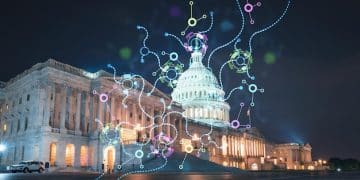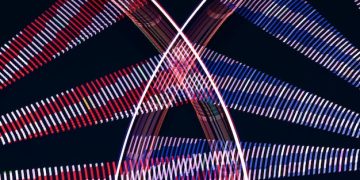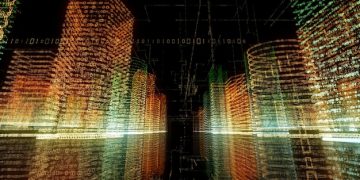Ethical Implications of Facial Recognition Tech in the US

Advertisements
The ethical implications of facial recognition technology in the US are profound, raising critical concerns about privacy, surveillance, bias, and the potential for misuse against civil liberties, demanding careful legislation and public discourse.
Advertisements
In an increasingly digital world, technologies evolve at an astonishing pace, often outpacing the ethical frameworks designed to govern them. Among these advancements, facial recognition technology stands out as a powerful innovation with far-reaching societal impacts. But what are the ethical implications of facial recognition technology in the US, particularly as its ubiquity grows?
The Pervasiveness of Facial Recognition Technology
Facial recognition technology, once confined to science fiction, has seamlessly integrated into various facets of daily life across the United States. From unlocking smartphones to enhancing security at airports, its applications are diverse and rapidly expanding. This widespread adoption, while offering convenience and perceived security benefits, simultaneously introduces a complex web of ethical dilemmas that warrant careful examination and public discussion.
Advertisements
Understanding the ethical implications of this technology requires acknowledging its current scope. For instance, law enforcement agencies are increasingly utilizing facial recognition for identification, criminal investigations, and even in real-time surveillance scenarios. Retailers employ it for loss prevention and customer analytics. Even theme parks and entertainment venues use it for streamlined entry and personalized experiences. This proliferation highlights a shift in how personal spaces and identities are perceived and processed by various entities.
Law Enforcement and Surveillance Concerns
The application of facial recognition by law enforcement raises immediate and significant ethical questions about mass surveillance. While proponents argue its utility in apprehending criminals and enhancing public safety, critics counter that it paves the way for a society where individual movements are constantly tracked, eroding fundamental freedoms.
- 📍 Persistent tracking of individuals in public spaces.
- 🚔 Potential for real-time surveillance without warrants.
- 🚨 Use in identifying participants in protests or public gatherings.
This perpetual monitoring capability poses a threat to the constitutional right to privacy and freedom of assembly. The transition from targeted surveillance to widespread, indiscriminate data collection shifts the burden of proof, making every citizen a potential subject of ongoing scrutiny.
Commercial Applications and Data Privacy
Beyond government use, the commercial sector’s embrace of facial recognition introduces its own set of privacy concerns. Businesses collect vast amounts of biometric data, often without clear consent or transparent policies on how this data is stored, used, or shared. Consumers might unknowingly provide their biometric information simply by entering a store or interacting with a smart device.
The monetization of this data further complicates the ethical landscape. While companies promise enhanced customer experiences or security, the underlying trade-off often involves individuals relinquishing control over highly personal and unique identifiers. The potential for data breaches, identity theft, or the resale of biometric data to third parties without explicit permission remains a significant risk.
The growing market for facial recognition technology and its integration into different sectors underscores the urgency of establishing clear ethical guidelines and regulatory frameworks. Without these, the technology’s benefits risk being overshadowed by its potential for invasive and harmful practices, challenging the core principles of privacy and individual autonomy in a democratic society.
Bias and Discrimination in Facial Recognition Algorithms
One of the most pressing ethical concerns surrounding facial recognition technology is its documented propensity for bias, leading to discriminatory outcomes. These biases often stem from the datasets used to train the algorithms, which historically have been less diverse, resulting in lower accuracy rates for certain demographic groups. This issue is not merely theoretical; it has tangible consequences for individuals, particularly those from marginalized communities.
Studies have repeatedly shown that facial recognition systems exhibit higher error rates when identifying women, people of color, and individuals who are elderly or very young. This disparity means that the technology is less reliable for these groups, leading to a greater likelihood of misidentification, false arrests, or denial of services. The implications are profound, as the technology is increasingly deployed in critical applications like law enforcement and border control, where accuracy is paramount to justice and civil liberties.
Racial and Gender Bias
The algorithmic bias against people of color, particularly Black individuals, and women is particularly alarming. This bias is not an inherent flaw in the concept of facial recognition but rather a reflection of the human biases embedded in the data collection and algorithm development processes. If a system is trained predominantly on images of lighter-skinned men, it will naturally perform less accurately when presented with faces that deviate significantly from that demographic profile.
- 💡 Inaccurate identification of Black individuals leading to false arrests.
- 👩⚖️ Gender misclassification, particularly for women and non-binary individuals.
- 📊 Poorer performance on individuals with darker skin tones.
Such inaccuracies can perpetuate and exacerbate existing societal inequalities, transforming technological tools into instruments of systemic discrimination. The idea that a technological system can be inherently biased against certain races or genders raises serious questions about its suitability for public deployment without rigorous, inclusive testing and continuous refinement.
Impact on Marginalized Communities
The disproportionate impact of biased facial recognition technology on marginalized communities cannot be overstated. For these communities, who already face systemic biases in various institutions, the addition of flawed technological surveillance creates another layer of vulnerability. A false identification by a facial recognition system can lead to significant disruptions in life, from unwarranted questioning to wrongful imprisonment, all based on an algorithmic error.
Furthermore, the knowledge that such technology is deployed, even if imperfect, can instill a sense of constant surveillance and distrust in public institutions, particularly among groups who are already over-policed. This erosion of trust can stifle free expression, limit public assembly, and deepen societal divides, fundamentally undermining the principles of equity and justice that a democratic society purports to uphold.
Addressing these biases requires a multifaceted approach: demanding more diverse and representative datasets for training, implementing rigorous independent auditing of algorithms for fairness, and establishing clear accountability mechanisms for the developers and deployers of such technology. Without these critical steps, the promise of facial recognition as a tool for safety and convenience risks becoming a new frontier for discrimination and injustice.

The Erosion of Privacy and Civil Liberties
Perhaps the most widely discussed ethical implication of facial recognition technology is its profound impact on privacy and civil liberties. The ability to automatically identify and track individuals in real-time, often without their knowledge or consent, fundamentally alters the traditional understanding of public and private spaces. This capability moves beyond a mere convenience; it shifts societal norms around anonymity and surveillance, raising questions about what it means to be free from constant digital scrutiny.
The concern isn’t just about what the technology can do today, but also what it might enable tomorrow. A future where every public movement, every social interaction, and every store visit is recorded and indexed against one’s identity paints a chilling picture of a surveillance state. This erosion of anonymity can stifle dissenting opinions, discourage public protests, and create a chilling effect on legitimate activities, as individuals become wary of being monitored and potentially misinterpreted.
The Right to Anonymity in Public Spaces
Historically, public spaces have offered an implicit right to anonymity, a freedom that allows individuals to move, associate, and express themselves without being identified or tracked. Facial recognition technology fundamentally challenges this notion. With ubiquitous cameras and advanced algorithms, the concept of being “just another face in the crowd” evaporates, replaced by constant, automatic identification.
- 👁️ Loss of privacy in everyday activities like commuting or shopping.
- 🚶♀️ Deterrence of free association and public protest due to surveillance fears.
- 🚨 Potential for creation of detailed personal profiles without consent.
This loss of anonymity has significant implications for civil liberties. If individuals fear that their mere presence at a political rally, health clinic, or religious institution could be recorded and linked to their identity, it could deter participation in these fundamental aspects of democratic life. The freedom to wander, observe, or gather without being cataloged is a cornerstone of individual liberty that is directly threatened by pervasive facial recognition.
Government Surveillance and Abuse of Power
The potential for government abuse of facial recognition technology is a particularly grave concern. While proponents argue its utility in preventing crime and enhancing national security, the line between legitimate security measures and intrusive mass surveillance is notoriously difficult to draw and maintain. History is replete with examples of powerful technologies being repurposed for oppressive ends, and facial recognition presents an unprecedented tool for control.
The risk extends beyond direct surveillance to the creation of vast, searchable databases of citizens’ faces and movements. Such databases, if compromised or misused, could be exploited for political targeting, social credit systems, or suppression of dissent. Without robust legal frameworks, independent oversight, and strict accountability, governments could use facial recognition to monitor political opponents, suppress minority groups, or maintain social order through fear rather than consent.
Safeguarding civil liberties in the face of this technology requires proactive measures: establishing strict limits on governmental use, mandating transparency, requiring judicial oversight for certain applications, and empowering citizens with legal recourse against misuse. The balance between security and liberty is delicate, and facial recognition technology significantly tips the scales towards state power, necessitating vigilant public and legislative engagement to prevent its potentially detrimental effects on individual freedoms.
Data Security and Privacy Risks
The deployment of facial recognition technology inherently involves the collection, storage, and processing of highly sensitive biometric data. Unlike passwords or physical keys, biometric identifiers like facial scans are immutable and unique to an individual. Once compromised, they cannot be changed, leading to lifelong vulnerability. This poses immense data security and privacy risks that extend far beyond typical data breaches.
The sheer volume of biometric data being collected, often by a multitude of entities—from law enforcement to commercial enterprises—creates a vast attack surface for cybercriminals. Each database, each point of collection, represents a potential vulnerability. The ethical dilemma intensifies when considering that this data is not merely a string of numbers but a direct digital representation of a person’s identity, with profound implications if it falls into the wrong hands.
Vulnerability to Data Breaches and Misuse
Biometric data is a prime target for malicious actors. A breach of a database containing facial recognition data could lead to unprecedented forms of identity theft. Unlike a credit card number that can be canceled, a compromised facial scan remains a permanent vulnerability. This raises critical questions about who is responsible for safeguarding this data and what measures are truly sufficient to protect it.
- 🔒 Permanent identity theft if biometric data is compromised.
- 🚨 Risk of unauthorized access to personal devices and accounts.
- 🌍 Potential for cross-referencing data across multiple platforms and databases.
Moreover, the misuse of this data extends beyond criminal activity. Imagine scenarios where biometric data is sold to advertisers for highly targeted, manipulative campaigns, or where it’s used by insurance companies to assess risk based on perceived health indicators inferred from facial features. The lack of clear regulations on data retention, sharing, and purpose limitation amplifies these risks, turning what might seem like a beneficial technology into a pervasive threat to personal autonomy.
Lack of Robust Regulatory Frameworks
Despite the escalating risks, the United States currently lacks a comprehensive federal regulatory framework specifically governing facial recognition technology and biometric data. While some states have enacted their own laws, this patchwork approach creates inconsistencies and loopholes, leaving citizens vulnerable depending on their location.
The absence of strong federal legislation means there are often no clear guidelines on:
– How long biometric data can be stored.
– Whether explicit consent is required for collection and use.
– Under what circumstances data can be shared with third parties.
– What recourse individuals have if their data is misused or breached.
This regulatory vacuum allows for a “Wild West” scenario where companies and government agencies operate with varying degrees of ethical consideration and security practices. The ethical imperative is clear: robust, comprehensive legislation is urgently needed to establish clear boundaries, enforce accountability, and protect individuals from the unique and permanent risks associated with their biometric identities being digitized and potentially compromised without their full understanding or control. Without such frameworks, the convenience offered by facial recognition comes at an unacceptable cost to fundamental privacy rights.

The “Chilling Effect” on Free Speech and Assembly
Beyond the direct implications for privacy and discrimination, facial recognition technology possess a more insidious ethical concern known as the “chilling effect.” This phenomenon refers to the suppression of legitimate rights and activities due to the fear of surveillance, identification, and potential repercussions. When people believe they are being watched, they are less likely to participate in protests, express dissenting opinions, or engage in activities that could be misinterpreted or used against them.
This effect is particularly pronounced in a democratic society where robust free speech and the right to peaceful assembly are cornerstones of civic engagement. The very act of exercising these rights now comes with the implicit understanding that one’s identity can be instantly captured and stored, creating a digital record that might be used by authorities or other entities in unforeseen ways. This fear, whether founded or not, is enough to stifle legitimate public discourse and political participation.
Suppression of Dissent and Activism
The primary concern regarding the chilling effect is its potential to suppress dissent and activism. If protestors know they can be identified, tracked, and potentially face legal consequences or social repercussions for their participation, it could significantly diminish their willingness to assemble publicly. This capability undermines the democratic process, where public demonstrations and collective expression are vital mechanisms for holding power accountable and advocating for change.
- 🚫 Reduced participation in political protests and demonstrations.
- 🗣️ Self-censorship of opinions on social media or public forums.
- ⚖️ Fear of misidentification or database inclusion leading to legal issues.
The technology provides an unprecedented tool for authorities to build databases of activists, analyze their networks, and potentially preempt or disrupt their activities. This creates a power imbalance, making it easier for governments or powerful institutions to monitor and control narratives, thereby limiting the scope of public debate and political action. The ethical question then becomes: is the perceived benefit of surveillance worth the inherent cost to fundamental democratic freedoms?
Impact on Public Engagement and Social Life
The chilling effect extends beyond overt political activities to everyday public engagement. If individuals feel they are constantly under surveillance, even in mundane public settings, it can subtly alter social behaviors. Spontaneous interactions, casual conversations, and the general sense of freedom to exist anonymously in public spaces begin to erode.
Imagine the implications for vulnerable groups, such as undocumented immigrants or individuals seeking healthcare services that might be stigmatized. The presence of facial recognition technology could deter them from seeking necessary assistance or participating in community events, fearing identification and potential adverse consequences. This leads to a less inclusive and dynamic public sphere, where perceived risks outweigh the benefits of engagement.
To mitigate the chilling effect, societies must establish stringent legislative safeguards that rigorously limit the use of facial recognition technology, particularly in public spaces and for purposes related to free speech and assembly. There must be clear prohibitions against using this technology to monitor or identify protestors and robust accountability mechanisms for any misuse. Protecting these fundamental rights requires a collective commitment to prioritizing civil liberties over the unchecked expansion of surveillance capabilities, ensuring that technological advancement strengthens, rather than diminishes, the foundations of democratic society.
Towards Ethical Governance and Regulation
Given the multifaceted ethical implications of facial recognition technology, from privacy erosion to algorithmic bias and the chilling effect, the imperative for robust ethical governance and comprehensive regulation in the United States is undeniable. The current patchwork of state laws and the absence of a unified federal framework highlight a critical gap that leaves individuals vulnerable and allows the technology to develop and proliferate without sufficient oversight. Addressing this requires a proactive, collaborative approach involving policymakers, technologists, civil liberties advocates, and the public.
The challenge lies in striking a balance: fostering innovation while safeguarding fundamental rights. This isn’t a call for a blanket ban on facial recognition, which has legitimate and beneficial applications in highly controlled environments (e.g., unlocking personal devices, secure authentication). Rather, it’s a demand for sensible, transparent, and accountable deployment that prioritizes individual liberties and societal well-being over unchecked technological expansion and commercial exploitation.
Proposed Policy Frameworks and Best Practices
Several proposals for governing facial recognition technology have emerged, ranging from outright bans on certain uses to stricter consent requirements and independent oversight bodies. A comprehensive framework would likely incorporate elements of these approaches, tailored to the specific risks associated with different applications.
- 🏛️ Moratoria or bans on governmental use in public spaces unless under strict legal mandate.
- 📜 Requirement for explicit, informed consent for commercial collection and use.
- 🤝 Independent ethical review boards and oversight bodies.
- ⚙️ Mandatory algorithmic audits for bias and accuracy before deployment.
- ⚖️ Development of clear legal recourse for individuals affected by misuse or misidentification.
- 🔐 Strict data security standards and limitations on data retention and sharing.
Best practices would also include public consultation processes to ensure that regulations reflect societal values and concerns. Transparency from both developers and deployers of the technology is crucial, allowing for public scrutiny and accountability. This means clear communication about where and how facial recognition is being used, what data is collected, and for what purpose.
The Role of Public Discourse and Advocacy
While legislation is critical, the ongoing discourse and advocacy from civil society organizations, academics, and informed citizens play an equally vital role in shaping the ethical landscape of facial recognition technology. Public awareness campaigns, educational initiatives, and grassroots movements can raise consciousness about the risks and empower individuals to demand stronger protections.
The ethical debate should not be confined to legislative chambers or tech conferences; it must be a widespread conversation within communities, schools, and homes. Informed public opinion can pressure lawmakers to act and encourage companies to adopt more responsible practices. Advocacy groups serve as essential watchdogs, monitoring the deployment of the technology, documenting abuses, and pushing for policy reforms.
Ultimately, the ethical governance of facial recognition technology is not a one-time legislative fix but an ongoing societal commitment. It requires continuous adaptation to new technological advancements, vigilant enforcement of regulations, and a sustained global dialogue about the balance between security, convenience, and fundamental human rights. The responsibility falls on all stakeholders to ensure that this powerful technology serves humanity’s best interests, rather than undermining the very foundations of a free and just society.
| Key Concern | Brief Description |
|---|---|
| 👁️ Privacy Erosion | Loss of anonymity and constant surveillance in public and private spheres. |
| ⚖️ Algorithmic Bias | Higher error rates for marginalized groups leading to discrimination. |
| 🔒 Data Security Risks | Vulnerability of immutable biometric data to breaches and misuse. |
| 🤫 Chilling Effect | Suppression of free speech and assembly due to fear of identification. |
Frequently Asked Questions About Facial Recognition Ethics
▼
It’s an ethical issue due to concerns over privacy erosion, the potential for mass surveillance, inherent algorithmic biases leading to discrimination, and the risks associated with storing and securing highly sensitive biometric data. These factors challenge fundamental civil liberties and societal norms.
▼
It significantly impacts privacy by eroding the right to anonymity in public spaces, enabling constant tracking of individuals, and facilitating the creation of detailed personal profiles without explicit consent. This widespread data collection raises fears of a surveillance state.
▼
Algorithmic bias refers to higher error rates for certain demographic groups, particularly women and people of color. This matters because it can lead to misidentification, false arrests, and discriminatory treatment in critical applications like law enforcement, exacerb perpetuating societal inequalities.
▼
Currently, the US lacks comprehensive federal regulations for facial recognition technology and biometric data. This absence creates a patchwork of state laws and leaves individuals vulnerable, as there are no consistent guidelines on data collection, storage, use, or sharing.
▼
Addressing these challenges requires a multi-pronged approach: establishing robust federal legislation, implementing independent algorithmic audits for bias, ensuring transparency in deployment, fostering public discourse, and empowering individuals with legal recourse against misuse. The goal is to balance innovation with civil liberties.
Conclusion
As facial recognition technology continues its rapid integration into American society, the critical ethical questions surrounding its deployment demand immediate and sustained attention. From the profound implications for individual privacy and the pervasive threat of mass surveillance to the deeply concerning issues of algorithmic bias and the chilling effect on civil liberties, the ethical landscape is complex and fraught with potential pitfalls. While the technology offers undeniable benefits in certain contexts, its unchecked proliferation poses significant risks to the foundational principles of a free and democratic society. Moving forward, a concerted effort is necessary—encompassing robust legislative action, stringent oversight, mandatory transparency, and an informed public discourse—to ensure that facial recognition is developed and utilized in a manner that upholds human rights and societal values, rather than eroding them.





